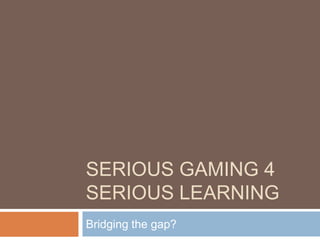SLALS526_MUVEs
- 1. SERIOUS GAMING 4 SERIOUS LEARNING Bridging the gap?
- 2. What bridges? ïĻ Digital immigrants ïĻ Digital Natives (Prensky 2001) ïĻ Teaching styles ïĻ Learning styles (Becker ïĻ Formal learning 2006) ïĻ Surface Learning ïĻ Informal learning ïĻ Extrinsic motivation ïĻ Deep learning ïĻ Direct instruction ïĻ Intrinsic motivation ïĻ Linear modes ïĻ Inductive teaching style ïĻ Inclusive, collaborative modes No single theory, different ways of learning & teaching
- 3. In a nutshell (Jonnassen, Wilson & grabinger, 1993) Behaviourist game design Constructivist game design ïĻ No extraneous information ïĻ Natural complexity and content of language ïĻ Simplifies comprehensibility ïĻ Avoids oversimplification ïĻ Reconstructs/replicates knowledge ïĻ Present multiple representation / ïĻ Abstracts instruction perspectives experience ïĻ Real world contexts ïĻ Focuses on acquiring skills ïĻ Engages reflective ïĻ Prescriptive sequences of practice instruction ïĻ Offer open learning ïĻ Supports individual learning environments
- 4. The situated perspective tenets ïĻ Knowledge not an object, memory not a location ïĻ Social interaction and negotiation in new situations ïĻ Learning happens in authentic contexts ïĻ Bridges the artificiality of classroom learning to real-life situations ïĻ Knowledge construction through participation ïĻ In given communities with specific ïĪ Culture, Language (jargon included) & Tools
- 5. MUVEs & MMORPGS ïĻ Multi-User Virtual Environments ïĻ Massive Multi-user Online Role Play Games ïĻ Add the 3d Component (â 2D â cards, chess) ïĪ Users evolve through an avatar (presence) ïĪ Interact with the environment & often with other MUVEs avatars MMORPGs Freedom Objectives, rules and rewards Social (Special Interest Groups = Competitive (individual, teams, guilds) SIGs) Creative ïĻ Creative Communities of Practice
- 6. Some MMORPGs used in Edu ïĻ MinecraftEdu widely used in primary, secondary ïĻ SecondLife soft and hard sciences ïĻ WoW Both Secondary & Higher Ed ïĻ Atlantis Remixed 9-16 y-o ïĻ Civilization V
- 7. Geeâs Affordances (foreword in Reinders 2012) A good game design include: ïĻ Well-ordered problems ïĻ Tools (and other players) to solve problems ïĻ Learning by negotiating, building, sharing, ïĻ Copious feedback to prepare for next stages, higher level ïĻ Next stages have new challenges (ZPD â cycle of expertise) ïĻ Playing & Learning through social interaction and mentoring ïĻ Two way narratives ïĻ Reach standards in different ways ïĻ Easy design so gamers can become designers (See Jonassen 1994)
- 8. Challenges for educators ïĻ Opportunity or disruption? â mechanics of gameplay ïĻ Learning to play versus learning language ïĻ Requirements (hardware and human resources, time) ïĻ Institutional buy-in ïĻ Curriculum Integration (alignment goals- assessment) ïĪ feedback, on-going assessment, formative vs summative ïĻ Needs more research & practice, check livebinders ïĻ See Stephen Thorneâs IATEFL 2012 Keynote ïĻ Read this post of teacher of German using WoW
- 9. Further Readings: ïĻ Becker, K., (2006) Games and Learning Styles, Academia.Edu [online] ïĻ Brown, J.S., Collins, A. & Duguid, S. (1989). Situated cognition and the culture of learning. Educational Researcher, 18(1), 32-42. ïĻ Jonassen, D.H., Wilson, B.G., Wang, S., & Grabinger, R.S. (1993). Constructivist uses of expert systems to support learning. Journal of Computer- Based Instruction, 20(3), 86-94. ïĻ Kkorthagen F.A.J., (2010) Situate Learning Theory and the Pedagogy of Teacher Education: Towards an integrative View of Teacher Behaviour and Teacher Learning. Teaching and Teacher Education, 26 (pp98-106) [online] ïĻ Lave, J., & Wenger, E., (1990). Situated Learning: Legitimate Peripheral Participation. Cambridge, UK: Cambridge University Press ïĻ Prensky M.,(2001) Digital Natives, Digital Immigrants. On the Horizon, MCB University Press, Vol. 9 No. 5, October 2001 ïĻ Reeve J. K. (2010) . Constructivism and Its Application to Game-Based Learning [online] ïĻ Reinders, H. (2012) Digital Games in Language Learning and Teaching, New Language Learning & Teaching Environments. Basingtoke, England: Palgrave MacMillan ïĻ Young, F. Y. (1993). Instructional Design for Situated Learning. Educational Technology Research and Development, 41 (1), 43-57.
- 10. Second Life Platform ïĻ 3d MUVE, not a game ïĻ Role Play is more than half of usersâ activities ïĻ Artists also promote their work ïĻ Learning Higher Ed for simulation ïĻ Language learning - CoPs & Slanguages symposium ïĪ Edunation, Virtlantis, Cypris Chat, Instituto espaÃąol, etc ïĪ Simulation, explorations and treasure hunts ïĪ French FL and VUW language program
- 11. VUW languages â Aims of project
- 13. Various Activities â levels of competence ïĻ Explorations, interviews, treasure hunts, ïĻ Set lessons directed by the course outline
- 15. Recommendations
- 16. Questions ? ïĻ Edith.paillat@vuw.ac.nz









![Further Readings:
ïĻ Becker, K., (2006) Games and Learning Styles, Academia.Edu [online]
ïĻ Brown, J.S., Collins, A. & Duguid, S. (1989). Situated cognition and the culture
of learning. Educational Researcher, 18(1), 32-42.
ïĻ Jonassen, D.H., Wilson, B.G., Wang, S., & Grabinger, R.S. (1993).
Constructivist uses of expert systems to support learning. Journal of Computer-
Based Instruction, 20(3), 86-94.
ïĻ Kkorthagen F.A.J., (2010) Situate Learning Theory and the Pedagogy of
Teacher Education: Towards an integrative View of Teacher Behaviour and
Teacher Learning. Teaching and Teacher Education, 26 (pp98-106) [online]
ïĻ Lave, J., & Wenger, E., (1990). Situated Learning: Legitimate Peripheral
Participation. Cambridge, UK: Cambridge University Press
ïĻ Prensky M.,(2001) Digital Natives, Digital Immigrants. On the Horizon, MCB
University Press, Vol. 9 No. 5, October 2001
ïĻ Reeve J. K. (2010) . Constructivism and Its Application to Game-Based
Learning [online]
ïĻ Reinders, H. (2012) Digital Games in Language Learning and Teaching, New
Language Learning & Teaching Environments. Basingtoke, England: Palgrave
MacMillan
ïĻ Young, F. Y. (1993). Instructional Design for Situated Learning. Educational
Technology Research and Development, 41 (1), 43-57.](https://image.slidesharecdn.com/slals526muves-121212214225-phpapp02/85/SLALS526_MUVEs-9-320.jpg)






